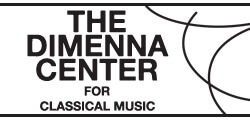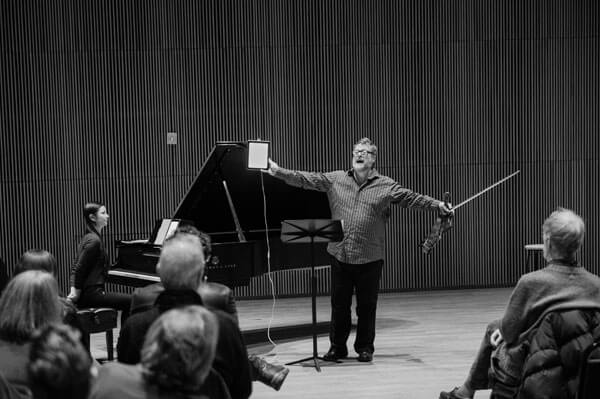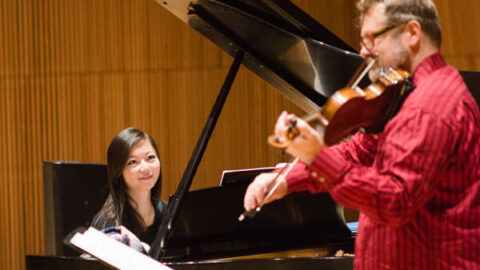 Friday evening, January 24, 2014, at the DiMenna Center began with the distinct smell of kettle corn and the refreshing sound of beer cans opening to signify the end of a another work week. The performance space, a large acoustic rehearsal room for the Orchestra of St. Luke’s, was occupied with a mix of spectators young and old as well as two very talented performers. A surprisingly casual affair, MC and solo violinist for the evening Todd Reynolds took front and center to introduce the works and supply a little banter which engaged the well-imbibed audience. He embraced much of the mission of this new concert series called Kettle Corn New Music which is based on the idea of “sharing music with friends” and finding an “alternative to more formal, traditional concerts.”
Friday evening, January 24, 2014, at the DiMenna Center began with the distinct smell of kettle corn and the refreshing sound of beer cans opening to signify the end of a another work week. The performance space, a large acoustic rehearsal room for the Orchestra of St. Luke’s, was occupied with a mix of spectators young and old as well as two very talented performers. A surprisingly casual affair, MC and solo violinist for the evening Todd Reynolds took front and center to introduce the works and supply a little banter which engaged the well-imbibed audience. He embraced much of the mission of this new concert series called Kettle Corn New Music which is based on the idea of “sharing music with friends” and finding an “alternative to more formal, traditional concerts.”

As the appointed starting time for the concert rolled by, it was announced to the audience — primed with food and alcohol — that the concert would begin a half hour late. No one seemed to mind. The program began with a world premier by Andrew Norman. Sabina, a work for solo violin, was said to be inspired by Norman traveling through Rome. He described the light shining through a thinly cut stone (not glass) window in a chapel and this was noticed through the timbre and textures he chose to construct the piece. The linear structure of the work conveyed what seemed like the duration of the day: slowly building as the sun rises and ending with a rather romantic melody as the day ends. A memorable start to say the least.
Ingram Marshall’s September Canons is not a new work, but it sounded just as fresh. Using solo violin, hooked up with electronics filtered through his laptop, Reynolds thoroughly described how the piece was to be performed. He even showed the audience his screen with the music and effects application which produced a carefully laid group of delays. This allowed each canon line of Marshall’s work to unfold into a brilliantly layered piece of tonal architecture which was seemingly executed with ease. But it wasn’t just the timbre and structure which was notable. One romantic-like melody — it sounded as if it could have been lifted from a Mahler symphony — shone through much of the thick minimalist texture. It was astonishing to see how much sound could be created with just one instrument as it filled the large acoustic space.
Mink Stole (1997) was Julia Wolfe’s contribution to the program. Her involvement in the project is highlighted in a promotional video for the event, but she was absent that night. Her work was contrasting in comparison to the first two pieces. It’s rhythmic and up-tempo character came to life in the hands of pianist Vicky Chow, who joined Reynolds on stage. The piano writing was intense and left me feeling sympathy for the poor Steinway, but Chow’s chops were solid.

Loren Loiacono, composer of A La Siciliana (a world premier) and on staff at Kettle Corn, rose at the front of the audience to introduce her piece. She talked about its construction as she curiously recalled, ”How far can I push this?” and described it as being influenced by “dance rhythms.” Her fascination here could not be overstated as the playful work extricated itself from the rest of the works on the program. It could have been easily set to dance or ballet and the parallel and homophonic structure made it reminiscent of Stravinsky. The expressiveness in rhythm and the dialogue between each of the instruments made it seem like several scenes, giving the piece an unfolding narrative.
The last two works on the program, both for piano and violin, were by more established composers. Lullaby for Natalie by John Corigliano was the dessert for the concert, as it contrasted with Loicacona’s intensity. The work was composed almost like an art song and soared by as it nearly wrapped up the program. But there was one more piece to be played. John Adam’s Road Movies was described by Reynolds beforehand as “18 minutes of romp and stomp.” This was not an exaggeration. A couple of times throughout the piece Reynolds had to tune his violin. The concert could have easily ended with the Corigliano as the audience (and the players) seemed fatigued.
This seems to be a common issue with many new music concerts: keeping the audience engaged while stretching the capacity of the listener’s ear. While the music is always appreciated, these performances could be helped by keeping the duration to a relative minimum. Nonetheless this concert was an overall success, both for the emerging composers and for a promising new series. The contrast and diversity of works on this program made for a great show. They were well executed by Chow and Reynolds, and the casual atmosphere made it easy to enjoy the music. Of course, nothing goes together better than popcorn, beer and new music.
























